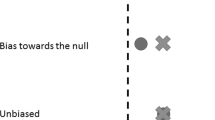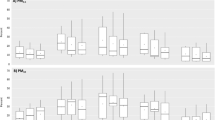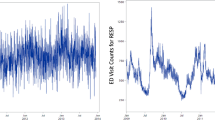Abstract
Many epidemiologic studies of the health effects of exposure to ambient air pollution use measurements from central-site monitors as their exposure estimate. However, measurements from central-site monitors may lack the spatial and temporal resolution required to capture exposure variability in a study population, thus resulting in exposure error and biased estimates. Articles in this dedicated issue examine various approaches to predict or assign exposures to ambient pollutants. These methods include combining existing central-site pollution measurements with local- and/or regional-scale air quality models to create new or “hybrid” models for pollutant exposure estimates and using exposure models to account for factors such as infiltration of pollutants indoors and human activity patterns. Key findings from these articles are summarized to provide lessons learned and recommendations for additional research on improving exposure estimation approaches for future epidemiological studies. In summary, when compared with use of central-site monitoring data, the enhanced spatial resolution of air quality or exposure models can have an impact on resultant health effect estimates, especially for pollutants derived from local sources such as traffic (e.g., EC, CO, and NOx). In addition, the optimal exposure estimation approach also depends upon the epidemiological study design. We recommend that future research develops pollutant-specific infiltration data (including for PM species) and improves existing data on human time-activity patterns and exposure to local source (e.g., traffic), in order to enhance human exposure modeling estimates. We also recommend comparing how various approaches to exposure estimation characterize relationships between multiple pollutants in time and space and investigating the impact of improved exposure estimates in chronic health studies.
This is a preview of subscription content, access via your institution
Access options
Subscribe to this journal
Receive 6 print issues and online access
$259.00 per year
only $43.17 per issue
Buy this article
- Purchase on Springer Link
- Instant access to full article PDF
Prices may be subject to local taxes which are calculated during checkout
Similar content being viewed by others
References
Laden F, Schwartz J, Speizer FE, Dockery DW . Reduction in fine particulate air pollution and mortality: extended follow-up of the Harvard six cities study. Am J Respir Crit Care Med 2006; 173: 667–672.
Zanobetti A, Schwartz J . The effect of fine and coarse particulate air pollution on mortality: a national analysis. Environ Health Perspect 2009; 117: 898–903.
Pope CA, Ezzati M, Dockery DW . Fine-particulate air pollution and life expectancy in the United States. NEngl J Med 2009; 360: 376–386.
Goldman GT, Mulholland JA, Russell AG, Strickland MJ, Klein M, Waller LA et al. Impact of exposure measurement error in air pollution epidemiology: effect of error type in time-series studies. Environ Health 2011; 10: 1–11.
Goldman GT, Mulholland JA, Russell AG, Srivastava A, Strickland MJ, Klein M et al. Ambient air pollutant measurement error: characterization and impacts in a time-series epidemiologic study in Atlanta. Environ Sci Technol 2010; 44: 7692–7698.
Gryparis A, Paciorek CJ . Measurement error caused by spatial misalignment in environmental epidemiology. Biostatistics 2009; 10: 258–274.
Sarnat SE, Klein M, Sarnat JA, Flanders WD, Waller LA, Mulholland JA et al. An examination of exposure measurement error from air pollutant spatial variability in time-series studies. J Expo Sci Environ Epidemiol 2010; 20: 135–146.
Thurston GD, Bekkedal MYV, Roberts EM, Ito K, Pope CA, III, Glenn BS et al. Use of health information in air pollution health research: Past successes and emerging needs. J Expo Sci Environ Epidemiol 2009; 19: 45–58.
McKone TE, Ryan PB, Özkaynak H . Exposure information in environmental health research: current opportunities and future directions for particulate matter, ozone, and toxic air pollutants. J Expo Sci Environ Epidemiol 2009; 19: 30–44.
Dominici F, Peng RD, Barr CD, Bell ML . Protecting human health from air pollution: shifting from a single-pollutant to a multipollutant approach. Epidemiology 2010; 21: 187–194.
Sarnat JA, Koutrakis P, Suh HH . Assessing the relationship between personal particulate and gaseous exposures of senior citizens living in Baltimore, MD. J Air Waste Manag Assoc 2000; 50: 1184–1198.
Sarnat SE, Coull BA, Ruiz PA, Koutrakis P, Suh HH . The influences of ambient particle composition and size on particle infiltration in Los Angeles, CA, Residences. J Air Waste Manag Assoc 2006; 56: 186–196.
Weisel CP, Zhang J, Turpin BJ, Morandi MT, Colome S, Stock TH et al. Relationships of indoor, outdoor, and personal air (RIOPA): Part 1, collection methods and descriptive analyses. Health Effects Institute 2005 Contract No 130: Part 1.
Baxter LK, Clougherty JE, laden F, Levy JI . Predictors of concentrations of nitrogen dioxide, fine particulate matter, and particle constituents inside of lower socioeconomic status urban homes. J Expo Sci Environ Epidemiol 2007; 17: 433–444.
Meng QY, Spector D, Colome S, Turpin B . Determinants of indoor and personal exposure to PM2.5 of indoor and outdoor origin during the RIOPA Study. Atmos Environ 2009; 43: 5750–5758.
Wilson WE, Brauer M . Estimation of ambient and non-ambient components of particulate matter exposure from a personal monitoring panel study. J Expo Sci Environ Epidemiol 2006; 16: 264–274.
Armstrong BG . Effect of measurement error on epidemiological studies of environmental and occupational exposures. Occup Environ Med 1998; 55: 651–656.
Zeger SL, Thomas D, Dominici F, Samet JM, Schwartz J, Dockery D et al. Exposure measurement error in time-series studies of air pollution: concepts and consequences. Environ Health Perspect 2000; 108: 419–426.
Szpiro AA, Paciorek CJ, Sheppard L . Does more accurate exposure prediction necessarily improve health effect estimates? Epidemiology 2011; 22: 680–685.
Sheppard L, Burnett RT, Szpiro AA, Kim S-Y, Jerrett M, Pope CA, III et al. Confounding and exposure measurement error in air pollution epidemiology. Air Qual Atmos Health 2012; 5: 203–216.
Özkaynak H, Baxter LK, Dionisio KL, Burke J . Air pollution exposure prediction approaches used in air pollution epidemiology studies. J Expo Sci Environ Epidemiol 2013 e-pub ahead of print 1 May 2013; doi:10.1038/jes.2013.15.
Özkaynak H, Isakov V, Sarnat S, Sarnat J, Mulholland J . Examination of Different Exposure Metrics in an Epidemiological Study. Air Waste Manag Assoc Magazine for Environ Managers 2011; 11: 22–27.
Klepeis NE, Nelson WC, Ott WR, Robinson JP, Tsang AM, Switzer P et al. The National Human Activity Pattern Survey (NHAPS): a resource for assessing exposure to environmental pollutants. J Expo Sci Environ Epidemiol 2001; 11: 231–252.
Strand M, Hopke PK, Zhao W, Vedal S, Gelfand E, Rabinovitch N . A study of health effect estimates using competing methods to model personal exposures to ambient PM2.5 . J Expo Sci Environ Epidemiol 2007; 17: 549–558.
Baxter LK, Burke J, Lunden M, Turpin BJ, Rich DQ, Thevenet-Morrison K et al. Influence of human activity patterns, particle composition, and residential air exchange rates on modeled distributions of PM2.5 exposure compared to central-site monitoring data. J Expo Sci Environ Epidemiol 2013; 23: 241–247.
Beevers SD, Kitwiroon N, Williams ML, Kelly FJ, Anderson HR, Carslaw DC . Air pollution dispersion models for human exposure predictions in London. J Expo Sci Environ Epidemiol 2013 e-pub ahead of print 28 February 2013; doi:10.1038/jes.2013.6.
Dionisio KL, Isakov V, Baxter L, Sarnat JA, Sarnat SE, Burke J et al. Development and evaluation of alternative approaches for exposure assessment of multiple air pollutants in Atlanta, Georgia. J Expo Sci Environ Epidemiol 2013 e-pub ahead of print 25 September 2013; doi:10.1038/jes.2013.59.
Jones RR, Özkaynak H, Nayak S, Garcia V, Hwang S-A, Linn S . Associations between summertime ambient pollutants and respiratory morbidity in NYC: comparison of ambient concentrations versus predicted exposures. J Expo Sci Environ Epidemiol 2013 e-pub ahead of print 28 August 2013; doi:10.1038/jes.2013.44.
Mannshardt E, Sucic K, Fuentes M, Reich B, Frey C, Jiao W . Comparing exposure metrics for the effects of speciated particulate matter on population health outcomes. J Expo Sci Environ Epidemiol 2013 e-pub ahead of print 14 August 2013; doi:10.1038/jes.2013.39.
Sarnat SE, Sarnat JA, Mulholland J, Isakov V, Özkaynak H, Chang H et al. Application of alternative spatiotemporal metrics of ambient air pollution exposure in a time-series epidemiological study in Atlanta. J Expo Sci Environ Epidemiol 2013 e-pub ahead of print 21 August 2013; doi:10.1038/jes.2013.41.
Hodas N, Turpin BJ, Lunden MM, Baxter LK, Özkaynak H, Burke J et al. Refined ambient PM2.5 exposure surrogates and the risk of myocardial infarction. J Expo Sci Environ Epidemiol 2013 e-pub ahead of print 29 May 2013; doi:10.1038/jes.2013.24.
Sarnat JA, Sarnat SE, Flanders WD, Chang HH, Mulholland J, Baxter L et al. Spatiotemporally-resolved air exchange rate as a modifier of acute air pollution related morbidity in Atlanta. J Expo Sci Environ Epidemiol 2013 e-pub ahead of print 19 June 2013; doi:10.1038/jes.2013.32.
Kumar N, Liang D, Abrams T, Comellas A, Chu AD . Satellite-based PM concentrations and their application to COPD in Cleveland, OH. J Expo Sci Environ Epidemiol 2013 e-pub ahead of print 18 September 2013; doi:10.1038/jes.2013.52.
Hodas N, Meng Q, Lunden MM, Rich DQ, Ozkaynak H, Baxter LK et al. Variability in the fraction of ambient fine particulate matter found indoors and observed heterogeneity in health effect estimates. J Expo Sci Environ Epidemiol 2012; 22: 448–454.
McConnell R, Berhane K, Yao L, Jerrett M, Lurmann F, Gilliland F et al. Traffic, susceptibility, and childhood asthma. Environ Health Perspect 2006; 114: 766–772.
Hoek G, Brunekreef B, Goldbohm S, Fischer P, Brandt PAvd . Association between mortality and indicators of traffic-related air pollution in the Netherlands: a cohort study. The Lancet 2002; 360: 1203–1209.
Acknowledgements
We thank the Natural Environment Research Council, Medical Research Council, Economic and Social Research Council, Department of Environment, Food and Rural Affairs and Department of Health for the funding received for the Traffic Pollution and Health in London project (NE/I008039/1), funded through the Environmental Exposures & Health Initiative (EEHI). The research was also supported by the National Institute for Health Research (NIHR) Biomedical Research Centre based at Guy’s and St Thomas’ NHS Foundation Trust and King’s College London. Related research was funded, in part, by the U.S. Environmental Protection Agency (Cooperative Agreement CR-83407201-0), NIEHS-sponsored UMDNJ Center for Environmental Exposures and Disease (NIEHS P30ES005022), and the New Jersey Agricultural Experiment Station. Natasha Hodas was supported by a Graduate Assistance in Areas of National Need Fellowship and an EPA STAR Fellowship. Related publications were made possible by a cooperative agreement between Emory University and the US Environmental Protection Agency (USEPA) (CR-83407301-1) and a USEPA Clean Air Research Center grant to Emory University and the Georgia Institute of Technology (RD83479901) Related research was funded by the NIH (ES014004) and the EPA (R833865).
DISCLAIMER
Although this work was reviewed by EPA and approved for publications, it may not necessarily reflect official Agency policy. The views expressed are those of the authors (s) and not necessarily those of the NHS, the NIHR or the Department of Health.
Author information
Authors and Affiliations
Corresponding author
Ethics declarations
Competing interests
The authors declare no conflict of interest.
Rights and permissions
About this article
Cite this article
Baxter, L., Dionisio, K., Burke, J. et al. Exposure prediction approaches used in air pollution epidemiology studies: Key findings and future recommendations. J Expo Sci Environ Epidemiol 23, 654–659 (2013). https://doi.org/10.1038/jes.2013.62
Received:
Accepted:
Published:
Issue Date:
DOI: https://doi.org/10.1038/jes.2013.62
Keywords
This article is cited by
-
Bench approaches to study the detrimental cutaneous impact of tropospheric ozone
Journal of Exposure Science & Environmental Epidemiology (2021)
-
Dynamic classification of personal microenvironments using a suite of wearable, low-cost sensors
Journal of Exposure Science & Environmental Epidemiology (2020)
-
Quantifying population exposure to air pollution using individual mobility patterns inferred from mobile phone data
Journal of Exposure Science & Environmental Epidemiology (2019)
-
The impact of air exchange rate on ambient air pollution exposure and inequalities across all residential parcels in Massachusetts
Journal of Exposure Science & Environmental Epidemiology (2019)
-
Population dynamics based on mobile phone data to improve air pollution exposure assessments
Journal of Exposure Science & Environmental Epidemiology (2019)



